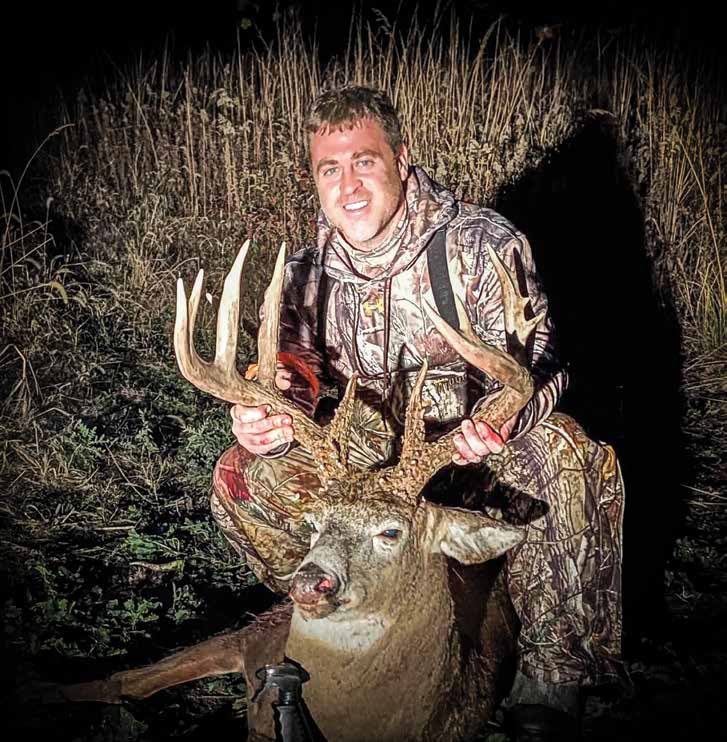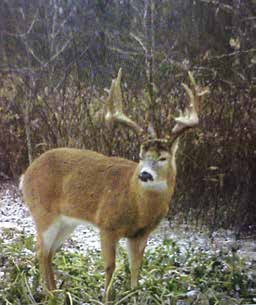The Right 40

It doesn’t take a lot of land to grow big deer, and Nathan Curtis is proof. Learn how the Indiana hunter used careful food plot management to take the buck of a lifetime.
By Scott Bestful
The oldest rule of real estate emphasizes location. Whitetail nuts can add their own addendum — one that stresses management. Indiana hunter Nathan Curtis combined those factors this past fall to take a giant buck on a 40-acre tract he and his brother manage.
“We were first aware of the buck in 2018,” said Curtis, a railroad engineer. “He was a regular at one of our mineral sites, which we load up with Imperial 30-06 mineral/supplement/vitamins. We think he was 2-½ years old that year and that he would be a special deer if he could make it a couple of more years. The next year, he showed up at the mineral site almost to the day from the year before, and it was clear he’d made a big jump. Then he kind of disappeared that year. Our neighbor had done some logging on his property, and I wondered if that ran him off, or if something in his world had just changed enough that we weren’t seeing him or getting pictures.
But the next year, the buck returned right on schedule.
The Pursuit
“And that year, he’d just exploded,” Curtis said. “I felt like he would gross over 200 inches. I’m convinced the mineral sites and food plots, which, except for some corn and beans we plant, are all Whitetail Institute products, are the major contributors to his big jumps in antler growth. I hunted him that fall to the exclusion of all other deer and just never had a chance at him. And it’s not like he was nocturnal. We had plenty of daylight pics of him, especially in late muzzleloader season. He was absolutely killing our Imperial Fusion plots, and later in fall, he was all over the Imperial Beets and Greens. I still shake my head about not being able to see him that year. It was either a case of wrong place, wrong time or maybe he was busting me going in to my stand. I guess I’ll never know, but it sure wasn’t for lack of effort. I lost track of the 150- to 160-inch bucks I let walk just holding out for him.”
The next fall, however, things took a huge turn for the better for Curtis.
“He’d put on tons more mass, but I think his overall score had gone down a bit, and I don’t know why,” Curtis said. “Still, he was one amazing deer, and I was devoting all my effort to him again. On the afternoon of Oct. 3, I was in a stand overlooking a plot that I’d put two varieties of seed in — Imperial Pure Attraction in one strip and Beets & Greens in the other — and at 5 p.m., I watched a big buck walk through that plot and then kind of slip back in the timber. I grabbed my rattling antlers and hit them a few times, and about 30 seconds later, I saw this giant silhouette across the field. I looked through my binoculars, and it was him.”
The buck turned toward Curtis and began walking at him, straight across the field.
“There’s a tree about halfway between us, and he stopped to rub that tree,” Curtis said. “I was shaking so bad when he first started coming at me, but the closer he got, the more I calmed down. There were three does in the plot when he started coming, and they ran toward me until they were right by the stand. I was wondering, ‘How am I going to pull this off?’ when the buck turned broadside at 40 yards. I drew the bow, picked my spot and hit exactly where I was aiming. The buck trotted off about 40 yards and tipped over. It was an amazing hunt, especially with rattling him in, and I will probably never top it, but I don’t care.”
The Curtis buck was a giant, grossing 183 inches B&C.
“The thing that impressed me the most was his mass,” Curtis said. “He had 8-inch circumferences at the bases and just carried his mass everywhere. He had kickers off his G2s and G3s, and super tall tines. And this is crazy, but his G2s were even taller — I’m guessing close to 15 inches — the year before.”

The Management Difference
Curtis credits the addition of high-quality food and mineral to improved deer numbers and quality on a farm he’d hunted since his start.
“This 40-acre property has been in my family forever,” he said. “I actually didn’t start deer hunting until I was 20, when my brother finally got me into it. It’s mostly hardwoods, but there’s a 9-acre field in the middle of it, plus a couple of smaller openings and a pond. When I first started hunting, it was common to see only three to five deer on a good hunt. Then my brother and I started reading about management and food plots and turned to the Whitetail Institute for products. At first, we took shortcuts, like I suppose a lot of guys do. Finally, we realized if we were going to do this, we should try to do it right, and we couldn’t believe the difference.
 It was just crazy. All of a sudden, we went from seeing a handful of deer to 20 or 30 on a normal hunt.”
It was just crazy. All of a sudden, we went from seeing a handful of deer to 20 or 30 on a normal hunt.”
The Curtis brothers initially focused their food plotting attention on the 9-acre interior field.
“It’s a fairly rectangular field that had been mostly switchgrass and other natives,” he said. “I bush-hogged it to create two circular plots, one on the north side and the second on the south. We rotate these between various Whitetail Institute varieties. Recently, we added a 20-foot-wide, 200-yard-long plot along the west side of the field. It’s just a long strip that I planted to Pure Attraction. We keep a path mowed along the edge of the field and then mowed lanes between each of the plots. We kept the switchgrass separating each plot so deer feel safe feeding in there, not like they’re just stepping out in one big field.”
As Curtis and his brother saw the appeal of those initial plots to deer, they looked for other potential sites.
“We had another 1-acre opening, and we got some Imperial Whitetail Clover going in there,” he said. “And we do have a couple of other spots where we’ve planted Roundup-ready corn and soybeans. Between those and our 30-06 mineral sites, I feel like we’ve maximized the potential for feed and attraction on the property. By summer, the 30-06 mineral and clover are bringing deer in, but it just seems to get better as the year progresses. We’re surrounded by lots of big agricultural land, and once the crops get harvested, we’re the only food in the neighborhood. That’s when it really gets good.”
Going Forward
Curtis’ land management experience only fueled his passion for whitetails and deer hunting.
“We started getting serious about things seven or eight years ago, and seeing what a difference it made just hooked me,” he said. “I’m able to save some nice vacation time, and when fall comes, I’m able to spend some time in the woods doing what I love. And while I might have shot my once-in-a-lifetime buck, that doesn’t mean I won’t keep at it and enjoy the whole process. Besides, I’ve already got trail-cam pics of a buck that has to be the son or grandson of the buck I killed, so you never know.”
